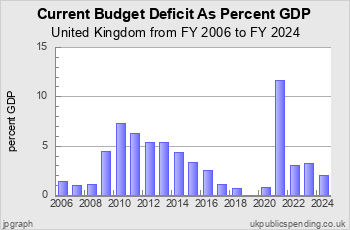What is the UK National Deficit?
For the fiscal year ending in March 2026:
The “current budget deficit*” is estimated to be £36.1 billion.
* Defined by Office of Budget Responsibility as (current expenditure - current receipts - depreciation).
UK National Deficit Analysis
This page shows the current trends in UK national deficit. Also see charts on UK debt history.
Recent UK Current Budget Deficits
Spending Data Sources
Expenditure data since 1983 comes from HM Treasury’s Public Expenditure Statistical Analysis reports.
Detailed table of spending data sources here.
Gross Domestic Product data comes from measuringworth.com.
Central government spending data begins in 1692.
Local authority spending data begins in 1868.
Site Search
Data Sources for :
GDP: data from measuringworth.com (but now unsupported)
Spending: B.R. Mitchell, British Historical Statistics
Debt: B.R. Mitchell, British Historical Statistics
> spending data sources for other years
On July 23, 2025, HM Treasury published its Public Expenditure Statistical Analyses (PESA) for 2025. ukpublicspending.co.uk uses the PESA tables of public spending at the "sub-function" level as its major data source for UK public spending.
ukpublicspending.co.uk has now updated its spending tables using data from PESA 2025. The update includes outturn spending data for 2023-24, and plans data for 2024-25. ukpublicspending.co.uk uses PESA's Table 6.4 for Central Government expenditure, Table 7.4 for Local Authority expenditure, and Table 8.3 for Public Corporation capital expenditure.
Since HM Treasury does not provide plans estimates for future Local Authority spending, ukpublicspending.co.uk provides "guesstimates" instead. This is done by extending the percentage increase in spending between 2023-24 and 2024-25 for each sub-function for the plans year. It is assumed that local authority spending reductions will not carry through to plans years.
Country and Region spending has been updated up to 2023-24. These are obtained from Chapters 9 and 10 in the PESA document.
Quick Links
Get spending chart.
Download spending table.
Download spending data series.
Review data sources.
Masthead
ukpublicspending.co.uk was designed and executed by:
Christopher Chantrill.
Report bugs here.
Budget News
Budget 2012: 50p tax rate scrapped and allowance raised
Personal allowance now close to £10,000.
Autumn Statement 2011
Chancellor George Osborne introduces six more years of pain.
Budget 2011: George Osborne set for 8bn pound windfall
Treasury revenue up, so no spending cuts in Budget 2011
> archive




